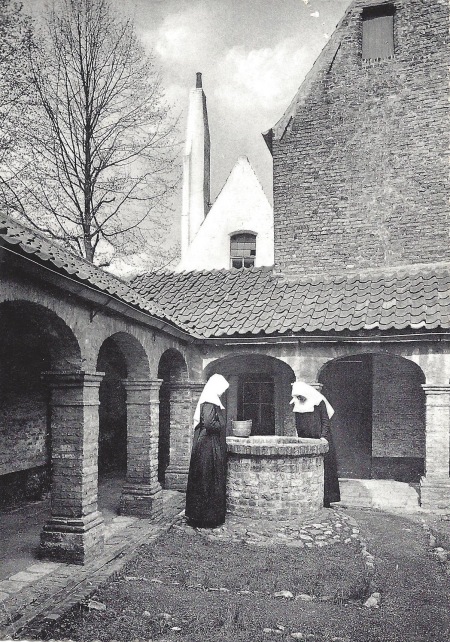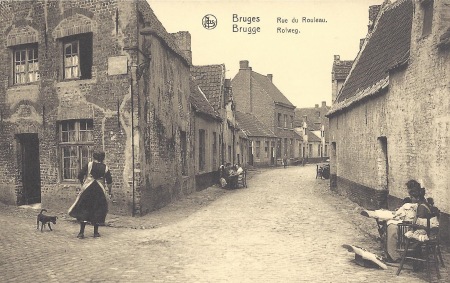 As someone who gravitates toward folk arts, I knew almost nothing about Belgium’s lacemaking industry before starting research for The Lacemaker’s Secret. But one of the best parts about writing the Chloe Ellefson mysteries is learning new things, and this topic was no exception.
As someone who gravitates toward folk arts, I knew almost nothing about Belgium’s lacemaking industry before starting research for The Lacemaker’s Secret. But one of the best parts about writing the Chloe Ellefson mysteries is learning new things, and this topic was no exception.
The mystery includes a strand of historical fiction featuring a Belgian farm girl, Seraphine. When Seraphine and her sister Octavie are orphaned at a young age, they find a home at a convent and lace school, The School of the Apostolic Sisters, in Bruges.
Women have made bobbin lace in Belgium for centuries, especially in the northern region of Flanders. Bruges is famous for it.
Historically, nuns ran schools in an effort to preserve the lace industry, and to teach girls a trade that would bring a bit of income. Most students were local girls “from the very poorest and lowest families” who came daily for lessons. For some, a bowl of soup at midday was their only meal.

A young Belgian lacemaker at work. This postcard image postdates Seraphine’s girlhood, but it helped me imagine her busy at her pillow. (Nels, Bruxelles)
Seraphine experienced the city for the first time when she traveled to Bruges. Walls surrounded the convent itself.

“Bruges: Beguinage, A Corner of the Cloister.” A beguinage housed religious women who lived in community but did not take vows. Originally the complex was a convent, but the two terms diverged. (An. Thill, Bruxelles)
I don’t have an interior photo of a workroom, but a visitor in 1887 described the scene:
The room was full of young women and children sitting in rows of three. Each had a little stand before her, and on it a sloping cushion with hundreds of pins and scores of wooden bobbins; while down the centre of it where the pins were covered by a strip of calico, lay the precious filmy lace growing under the flying fingers. Our entrance, though it created evident surprise and interest among the sixty workers and the three white-coifed sisters who sat in charge of them, caused no cessation in the work… The bobbins clattered, the pins were pricked into the holes on the patterns, the delicate fingers…worked on ceaselessly, as we moved up between the lines of dentellieres to meet a pleasant sister, who welcomed us with charming courtesy in perfect French. (Rose G. Kingsley)

Ms. Kingsley said the lacemakers were “of all ages from seven years old and upwards,” but the little girl in this picture looks younger. (“Lace Manufactory, Chs. Berbigette, Antwerp”)
There were several other lace schools in Bruges, and over 900 in Belgium. The students could stay as long as they wished. Although some remained in the Beguinage as adults, most participated in lacemaking as a cottage industry. It was common for Belgian women to finish their own chores, then move outside to make lace in the sunshine, often visiting with friends and neighbors as they worked.
Many different types of lace were made in Belgium, and in the 1800s, perhaps 150,000 women earned their living with their bobbins and pillows. But as other industries grew, women started taking better-paying jobs in factories. Many people feared the knowledge of particular styles or patterns might be lost. In 1900, thousands of women in Bruges and other Flemish cities still supported themselves by making lace. By 1975—close to Chloe’s time—only a few hundred of them were left, mostly older women looking to earn some extra money.
Fortunately, some younger women have helped inspire a bit of a revival. And notably, one of the old convent lace schools (the Sisters of the Immaculate Conception) has been turned into a lace museum:
The Bruges’ Lace Centre is a private cultural institute which aims to preserve the lace handicraft for future generations. It manages a museum and a specialized library, organizes courses and lace workshops as well for youngsters as for adults, trains lace teachers and publishes, apart from the international magazine “KANT”, other publications. The Bruges’ Lace Centre’s ambition is to develop itself to the real knowledge centre of lace in Bruges and to a reference institute in the world of lace.
I hope to get there one day!
Tags: bobbin lace, Bruges, Chloe Ellefson Mystery series, The Lacemaker's Secret



November 13, 2018 at 3:17 pm |
Thank you for sharing. I learnt from my grand-ma that they would go outside so they would have more light to work on very small details.
November 13, 2018 at 8:10 pm |
That makes sense to me, Agnes. I’d want all the light I could get!
November 14, 2018 at 6:11 am |
Such a different perspective from that in The Ruins of Lace by Iris Anthony. Your post is much more in line with the my memory of women in Greece sitting outside, making lace while the very late dinner was cooking
November 14, 2018 at 12:27 pm |
Liz, I’m not familiar with The Ruins of Lace, but I have seen many references to women working outside, and seen many images. What a lovely memory to have of Greece! I hope to visit a lacemaking area one day.
November 14, 2018 at 10:37 am |
“Rue des Aiguilles”…”Street of Needles.” Perfect location for lacemaking. Kristin
November 14, 2018 at 12:25 pm |
Kristin, I didn’t know that. But it is the perfect name!
November 14, 2018 at 8:26 pm |
Lovely post, Kathleen. It’s amazing to me how inventive the human race is and for women to create beauty and income in varied ways. Lacemaking has to be one of the most beautiful.
Arletta
November 18, 2018 at 6:18 pm |
Hi Arletta – it amazes me, what people can do. The intricacy of some of the laces boggles my mind. Truly inspiring!
November 17, 2018 at 7:43 pm |
My mother said as a girl that she knew how to tat. I guess it was something like lace making. She and her sisters made doilies i think. I really enjoy the historical aspects, and am so glad book 10 will come out. Looking forward to the details.
November 18, 2018 at 6:17 pm |
Hi Jill – Thanks for the good thoughts! I too am very happy that it worked out to keep Chloe #10 on schedule. I’ve done a bit of tatting, which is done with your fingers and a small shuttle. I haven’t tried bobbin lace yet but hope to!
November 19, 2018 at 7:44 am |
I was lucky enough to visit the Baginage after hearing of it in my medieval studies class. I’ve been picturing it while reading the early pages of the book, and here are the pictures to confirm it.
November 19, 2018 at 12:09 pm |
Tess – ooh, I hope to get there one day! I had no idea of the role that convents played in preserving lace traditions until I started working on this book.
December 10, 2018 at 1:56 pm |
Do try bobbin lace! It’s knot😀 the monotony of just rings and chains in tatting. I used knitting blocking squares as a pillow to see if I’d like it before investing in the real thing. It’s fun and feels like a major accomplishment when a tiny piece is done.
December 10, 2018 at 2:11 pm |
Thanks for encouragement, and for the tip! I’ve done some tatting but had to give it up because it put too much strain on my fingers. I’m looking forward to giving bobbin lace a try.
January 18, 2021 at 2:36 am |
[…] is famous for its lace making. It crafts some of the most luxurious lace in the […]